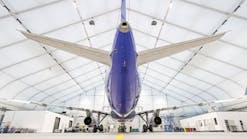Creating Connections: Creating New Airport Revenue Opportunities through Traveler and Airline Relationships
Airports are an obligatory stop on any flight journey, yet they continue to have little if any connection — digital or otherwise — with travelers themselves. The advent of the self-connecting passenger gives airports new ways to connect with travelers passing through their facility and, just as important, provides entirely new business opportunities.
Airports are already evolving from utilitarian pass-through venues for flights to comprehensive destinations serving different traveler needs and desires. Retail, food and beverage, lounges, even other amenities like spas and movie theaters have become commonplace at airports around the globe, all intended to create a positive experience for the leisure and business traveler. And, of course, drive revenues for the airlines, concessionaires, retail operators and airport authorities themselves.
But despite this focus on the travel customer’s needs, most airports don’t have a direct digital connection with the traveler. Their online presence is usually limited to providing flight schedules and car park information. They have little visibility into individual passenger itineraries and no way to engage with the traveler before they enter the airport. This relegation to a passive role in the passenger’s journey doesn’t help build strong customer relationships and it means lost opportunities to generate revenue from travelers.
How can airports claim a share of the air travel buy flow? How does their inability to create connections with airlines and travelers affect their position in the air travel ecosystem? And how can airports create direct connections with the airlines and travelers they serve cost-effectively, and profitably?
Tapping into the Air Travel Buy Flow
Existing online travel reservation systems don’t consider airports’ goals at all. It’s all about the airline brand, the connection and travel time, the price. It’s all about “minimum connection time,” not the right amount of time to let a passenger get from one plane to another with a minimum of stress and plenty of time to relax, browse, shop and spend money on airport amenities. Airports want to be more than a thoroughfare between one flight and another (it’s why they often put the thoroughfare through shops as soon as you clear passport control).
The rise of the self-connecting passenger is driving airports to consider a more active role in travel planning and buying. It’s estimated that up to 92 percent of travelers are willing to self-connect under the right circumstances. Currently, as much as 4 percent of all passenger bookings could involve a self-connection, according to research from Cranfield University, the University of Edinburgh Business School and Linköping University.
Self-connecting travelers can choose which airports they transfer through, and the airports that successfully cater to this market are going to win business.
Today, there are range of technical solutions that make it relatively easy for airports to connect to airline systems. An airport can quite easily acquire a fully branded and integrated online reservation system, optimized for the web and mobile phones, that features just its airline clients and just the flights that use its facility.
Of course, seizing this revenue opportunity isn’t quite as simple as plugging booking engine into an airport’s current website; there’s plenty of competition. Nearly every airline has a sophisticated booking infrastructure designed to encourage travelers to book with them directly, and there are hundreds of OTAs and travel inventory aggregators that offer booking capabilities as well.
For airports to compete, they need more than just a booking engine; they need to leverage their unique position in the travel marketplace: their facility. Airports who want to cater to self-connect passengers can consider a range of support services, including:
- A booking system, yes, a basic requirement;
- Help desks and service personnel trained to deal with self-connecting passenger issues
- New signage
- Through-bag services to accelerate and ease the transfer of bags
- Optimized bag-recheck services, be it through location or with personnel assistance
- Keeping self-connecting passenger traffic airside, thus removing visa and document issues and giving the passenger more time to browse and buy in terminal shops
- A fast-track service for connecting passenger traffic
- Positioning the airport as a service and support provider, thus reducing the anxiety and frustration that can accompany the self-connecting passenger
No other entity in the passenger’s journey can provide these services, and the revenue potential is considerable. Travelers are willing to pay for these services, bundled as part of their travel purchase or purchased as an add-on later. And they’re willing to be notified about (and purchase) enhanced airport services. If airports were to take a more active role in the sale and support of travel products, they could improve their relationship with both their primary customers — airlines — and the passengers using their facilities.
Increasing an Airport’s Profile as a Destination
Boosting direct ancillary revenue from on-site services isn’t the only benefit airports gain by creating connections with travelers. Direct engagement also boosts the profile of the airport and makes it more attractive as a hub, destination or transfer point.
Different airports have different goals: Some are at capacity but would welcome transfer efficiencies or capacity insights; others want to boost passenger traffic; others want to increase the time passengers have to browse and shop; others want to reduce visa and documentation errors; still others want to play a larger role as a destination marketer.
Many small hub or non-hub airports face challenges promoting themselves as a destination, and continually lose traffic to the nearest large hub. With additional connectivity to both airlines and travelers, however, airports can attract new routes and passengers, and increase its ability to meet the demand for air travel in its region. By creating better experiences for travelers not only as they pass through the airport’s facility, but through the reservation process and with relevant ancillary services, a smaller regional airport can compete with bigger hubs on quality of service.
Creating Connections through Technology – Even During Disruptions
One area where quality of service matters most is during irregular operations. Providing support services that help travelers during disruption scenarios is an excellent opportunity to build a stronger relationship with the customer and provide a new revenue stream for the airport.
It’s important to note that “irregular operations” to the first-time, inexperienced traveler could simply mean the transfer itself from one plane to another. They may not speak the language, understand the signs, get confused by the process and find themselves landside and in trouble.
Airports primarily control the traveler relationship during disruption through service desks, assisting travelers who suddenly find their travel plans up-ended. These travelers may have had their trips interrupted, disrupted or ruined because of flight delays, but given the right tools, airport service personnel are uniquely positioned to understand what alternatives exist for the traveler to continue their journey.
In disruption scenarios, travelers are almost always grateful for assistance. Likewise, airport service desks could make a range of hotel accommodations available to stranded passengers — even propose an event or activity in the vicinity while they away more information in order to complete or continue their journey. At every point where things go wrong for the disrupted traveler, the airport can be ready with a dual solution – one that serves the traveler and provides a new revenue source for the facility.
To do this effectively, airports need trained personnel and connections to airline systems and to other travel providers’ inventory for things like hotel rooms and event ticketing. Some technical solutions allow airports to sell not just airline tickets, but to establish an online presence with a fully branded, integrated booking solution that allows them to bundle flights with their own ancillary products, be it VIP lounge access, preferential treatment or fast-track lines, baggage handling, longer layovers, or coupons.
The good news is airports don’t have to reinvent the wheel to achieve these goals. The right technology partner can offer airports a platform that allows them to connect to both sets of customers they serve – airlines and travelers – without requiring a massive IT investment or a disruption to existing systems.
The right technology platform also eliminates the need to establish connections with airlines’ inventory on an individual, case-by-case basis, allowing airports to quickly begin offering travelers the ability to book and purchase with them directly. For airports that want to create these profitable, direct traveler connections and boost the profile of their destinations, the first step is finding the partner that can help them reach new heights
David Vis is the director of growth at Air Black Box (www.airblackbox.com). David has decades’ experience in online travel from the first days of Amadeus’ online travel service, working for several major airlines, creating major destination portals like LasVegas.com and more recently, the front-end for the Value Alliance in Asia, the world’s largest low-cost carrier alliance in an equally dynamic travel marketplace. He’s spent many years in uncounted airports large and small on every continent, travelling mostly in peacetime but occasionally not. He’s experienced first-hand most traveler tribulations, and enjoyed those times when it all works the way it should.





